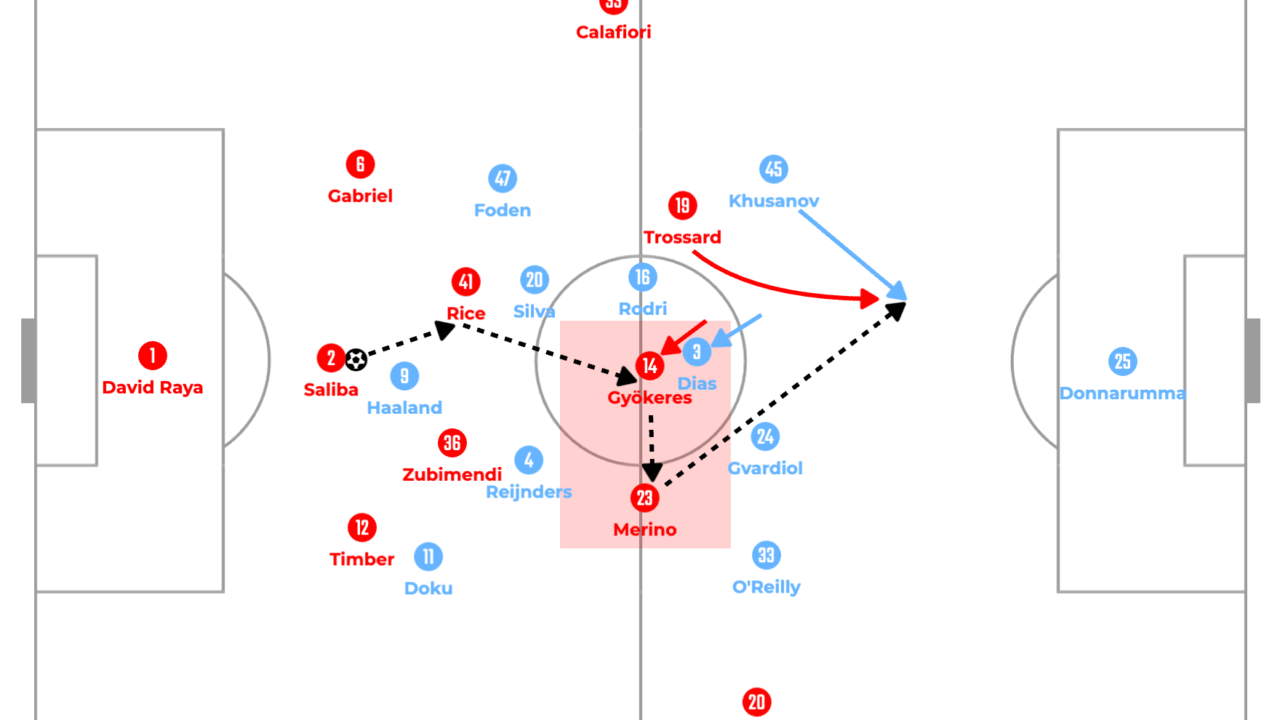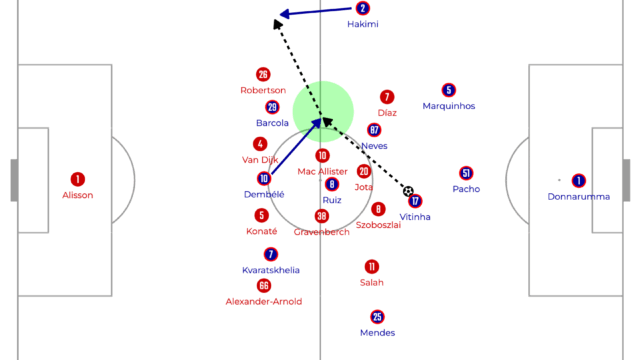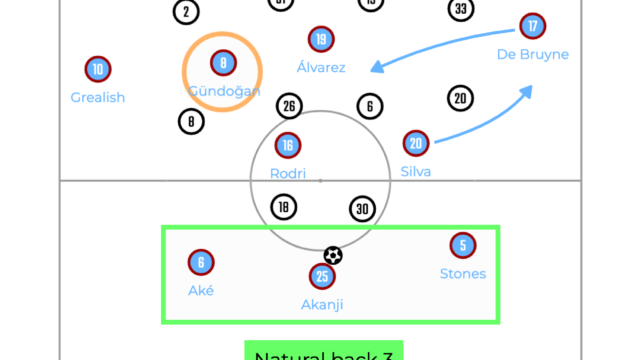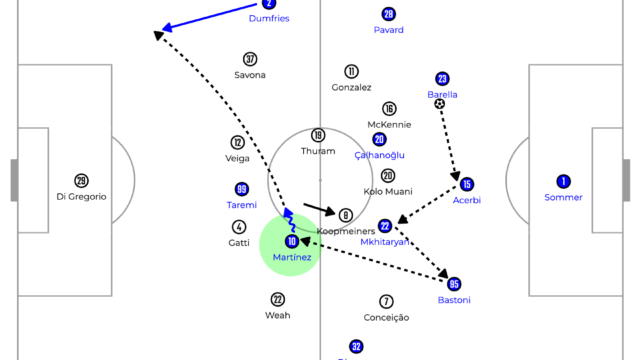Introduction
After many years of struggle, Arteta has finally built the best squad ever and it seems like one of the most realistic seasons to win something big. In contrast, Pep’s reconstruction of Man City is just underway after a disappointing season as not only players but also he welcomed new coaches, such as Pepijn Lijnders or Kolo Touré.
The power balance between them has changed in the recent years as now Arsenal are seen as the favourites in this encounter, so now it is time for Pep to deliver something to overcome the odds.
And the signs of changes had already been found in their previous league game against Man United. Even though Man united were not as good as “the big six” are supposed to be, Man City scored their third from a long counterattack from their own half and closed the game with the back five at the end. Also, there were some negative sides, such as having been played through when they tried to press high.
These things happened that night at the Emirates as well. Let’s find out.
Line up
Here’s the line up of the game.

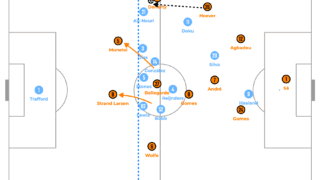
Arsenal’s Build up & City’s Lack of Intensity
Arteta’s side started the game strongly, as many expected. The reason behind it was, of course, the lack of intensity of Man City’s pressing.
“The lack of intensity” in this context means that what they tried to do was not so wrong from the tactical perspectives, but they couldn’t execute it well because of the lack of their physical capabilities such as speed, duels or endurance.
First of all, here’s the first build up play from Arsenal and how Man City tried to press against it.

As usual, Doku closed down Saliba with cutting the passing lane to Timber, and the back line shuffled across and pushed O’Reilly forward to take care of Merino. At the end, Raya kicked the ball away and O’Reilly was about to win it, but he couldn’t control his touch and Zubimendi secured the second ball and Arsenal could progress into the opposition half.
Like it was mentioned, this structure which the wingers apply pressure on the centre backs from the outside and lock them in the congested middle area is not wrong at all, but one mistake, which is miscontrolling the ball when intercepting it, can result in the error of the entire pressing sequence.
This time Man City were about to win the ball there, overall Arsenal played through the opposition pressure frequently at the beginning of the game.
The illustration below shows how Arsenal found the route to beat the pressure from Doku.

This has happened to City a lot this season. Doku presses on Timber from the outside, but it was so slow and late that he could easily open his body and find the best option possible, meaning the “lack of intensity” from Doku. This forced Reijnders to manage both Zubimendi and Merino, so it was difficult for him to close down the opponent receiving the ball as he couldn’t be sure which one was to receive it. Therefore, Merino was often able to receive the ball in between the lines and Arsenal had comfortably progressed into the opposition half.
Not only through the wide area, but also they could exploit the space through the middle.

Both Silva and Reijnders were marking close to Rice and Zubimendi and Rodri was looking after Trossard. Then, Gyökeres dropped into the space in between the lines and laid it off to Merino. Following Gyökeres’ movement, Trossard made a run in behind through the gap in the back line. Khusanov did a brilliant job here, and he made an impressive performance in terms of covering the space in behind with his pace, but this combination was extremely organised from Arteta’s side.
Another frequent pattern had occurred when Rodri jumped to Rice or another player in the deeplying midfield position.

In this case, Rodri left his position to tightly mark Rice, but this vacated the space in between the lines. And also, as Haaland pressed on Raya, Reijnders needed to manage both Zubimendi and Merino, again. Raya found Trossard inverting into the space in between the lines and he switched the ball to the right and Timber received it in the space which was open because Doku stuck to Saliba and O’Reilly was pinned by Madueke.
If even Rodri stepped up to mark someone with accepting to open the space in between the lines, they must have applied more intense pressure on the ball tirelessly and consistently to force errors of passes or controls of the ball. Otherwise, they would just give space for the opponents without any pressure, meaning the opponent on the ball can do whatever he wants to do, and this is what happened to City’s pressing so far.
Haaland from Long Counterattack
In contrast to what it seemed like, it was Man City who got the first in the 9th minute. Haaland scored from a long counterattack after winning the ball back in their own half. It was a quick transition to create a 3v2 just in front of Arsenal’s box.

This illustration simplified a little bit, but what happened was Calafiori delivered a cross, curving away from the goal and Reijnders tried to clear it away from the box. It was headed back by Zubimendi and it became an uncontrolled situation. Finally, the ball was laid off by Haaland and Reijnders sprinted to get it and carried it forward, then provided a gentle pass to Haaland who finished it calmly. Pep’s team showed the ability of Reijnders to carry the momentum forward and Haaland to outrun Gabriel and finish clinically, which were extremely suitable to play this kind of counterattack.
There was another counterattack from Man City in the first half, but this time from winning the ball back higher up the pitch.

Not every time Man City failed to press and in the 24th minute, Khusanov intercepted the ball and played to Rodri who quickly found Silva. Then, he delivered a cross and Reijnders dived into the box, but Merino sprinted back to clear the ball away. Reijnders, again.
Man City under Pep had prioritised keeping the ball after winning the back, but this shows how they have changed. It becomes more and more difficult to break down the opposition deep defensive block, so it is crucial to attack when the opponents are disorganised and it is often when the opponents lose the ball.
Introduction of Back 5
Arsenal conceded early, but overall it had been their game, although they needed to wait more than half an hour to register their first shot in the game. After conceding the goal, they kept pressing with higher intensity than Man City, such as a double effort from Gyökeres pressing to Dias and even to Donnarumma to lock them in and force an error. Arsenal keep pushing.
After 30 minutes, Man City became a back five for the first time in the game, but it might not be what they wanted at the moment. It was Foden who dropped back into the last line this time.

As Calafiori stepped up either in the wide channel or inside the defensive block, the right winger Foden started to drop into the back line to nullify the opposition overload. Another reason why it was Foden would be Khusanov in the right fullback position, who can play a central role, so there was no problem for them to shift into the back five in this way.
This back five was not the eternal one, so when they successfully pushed Arsenal back into their half, Foden stepped up to be back into the back four system.
Man City kept the lead until the whistle was blown.
Eze & Saka, Immediate impact
Arteta substituted the attackers on the right side and this changed the game. Eze and Saka came onto the pitch replacing Madueke and Merino.
From the first minute of the second half, Arsenal easily exploited City’s left side with Eze and Saka, being illustrated below.

Eze repeatedly received in the pocket, turned forward and linked with Saka against O’Reilly.
Of course, Eze’s skill makes the difference here, but the problem for City is that they couldn’t close the middle with a 4-4-2. From a tactical perspective, Doku was instructed to press from the outside of Timber or Saliba, so he would have thought it was not his job to close the middle. From an “intensity” perspective, keeping compactness and shuffling across is more demanding than expected. Not easy for everyone.
Maintaining the compact defensive block with a 4-4-2 system is only possible for teams who trained and organised well. This system is considered one of the most balanced, but covering the whole width with four players in each line requires every single one to make an effort to keep shifting across as the ball moves.
Here’s another example of Arsenal playing through the second line by playing around.

As Man City couldn’t shift across as a team well and O’Reilly couldn’t close Saka down, he was able to gain space to drive towards the goal when he received the ball. This got City defenders just to drop into the box, and Arsenal kept pinning City in the final third.
That’s why Pep decided to make it the back five.
Pep’s Defensive Game & Lack of Experience
Ake was on in the 68th minute and he joined the back line to make it the back five. This gave City extra cover at the back so that it became more difficult for Arsenal to exploit wide areas.
In less than 10 minutes after replacing Foden with Ake, Pep took Haaland off and reinforced the midfield with Nico González. After this, Man City started to try their best to defend the box at all costs to keep the lead. And in the 87th minute, Stones and Savinho came on as the final substitutions from Pep.
On the other hand, Arteta replaced Timber and Trossard with Martinelli and Nwaneri to bring more attacking threat against City’s deep defensive block. At the end, the game looked like this.

To be fair, Arsenal couldn’t create any goal scoring opportunities by breaking down City’s 5-4-1 defensive block, including set pieces. Donnarumma gave City more confidence in the box, surely.
However, the equaliser came from the inexperience from Pep’s side in his defensive game. After defending an Arsenal’s corner kick, they gained the opportunity to progress the ball forward. But, they lost the ball in the midfield and before they came back to close the space in behind, Martinelli made a run in behind and Eze delivered a beautiful ball with perfect weight on the ball.

In this kind of scenario, Man City might better let a few players go forward and stay at the back. There was no need to push the lines up. And also, especially Gvardiol wasn’t ready to drop back. Always being ready to drop back while pushing up the line is the basic of defenders and this needs to be executed perfectly every time to keep the clean sheets in this kind of game.
Arteta secured a point with the substitutions, but breaking down the opposition deep defensive block set will remain the topic like Pep had always been struggling. One last step for them as they are almost perfect in other areas.
